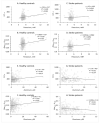Association of Metallic and Nonmetallic Elements with Fibrin Clot Properties and Ischemic Stroke
- PMID: 38792655
- PMCID: PMC11122299
- DOI: 10.3390/life14050634
Association of Metallic and Nonmetallic Elements with Fibrin Clot Properties and Ischemic Stroke
Abstract
Objectives-Metallic elements and fibrin clot properties have been linked to stroke. We examined metallic and nonmetallic elements, fibrin clot lysis time (CLT), and maximum absorbance (Absmax) in relation to ischemic stroke. Design-A case-control study of ischemic stroke patients vs. healthy individuals. Subjects and Methods-Plasma and serum were collected from 260 ischemic stroke patients (45.0% women; age, 68 ± 12 years) and 291 healthy controls (59.7% women; age, 50 ± 17 years). Fibrin CLT and Absmax were measured using a validated turbidimetric assay. Serum elements were quantified by inductively coupled plasma mass spectrometry (ICP-MS) and optical emission spectrometry (ICP-OES). Data were analyzed by bivariate correlations and multiple or logistic regression. Results-In female stroke patients, copper, lithium, and aluminum were significantly lower compared with controls; in male stroke patients, potassium was lower, and beryllium was elevated. In female and male stroke patients, iron, zinc, nickel, calcium, magnesium, sodium, and silicon were significantly lower, while strontium was elevated. Positive correlations between fibrin clot properties and metals, observed in healthy controls, were lost in ischemic stroke patients. In multivariate regression analysis, fibrin CLT and/or Absmax was associated with zinc, calcium, potassium, beryllium, and silicon in stroke patients and with sodium, potassium, beryllium, and aluminum in controls. In logistic regression analysis, stroke was independently associated with lithium, nickel, beryllium, strontium, boron, and silicon and with sodium, potassium, calcium, and aluminum but not with fibrin CLT/Absmax. Conclusions-Various elements were associated with fibrin clot properties and the risk of ischemic stroke. Lithium, sodium, calcium, and aluminum abrogated the association of fibrin clot properties with ischemic stroke.
Keywords: fibrin clot properties; ischemic stroke; metals; nonmetals.
Conflict of interest statement
Author I.W. is employed by the company Medicover, Poznań, Poland. The remaining authors declare that the research was conducted in the absence of any commercial or financial relationships that could be construed as a potential conflict of interest.
Figures




Similar articles
-
Homocysteine thiolactone and other sulfur-containing amino acid metabolites are associated with fibrin clot properties and the risk of ischemic stroke.Sci Rep. 2024 May 16;14(1):11222. doi: 10.1038/s41598-024-60706-2. Sci Rep. 2024. PMID: 38755170 Free PMC article.
-
Homocysteine thiolactone contributes to the prognostic value of fibrin clot structure/function in coronary artery disease.PLoS One. 2022 Oct 27;17(10):e0275956. doi: 10.1371/journal.pone.0275956. eCollection 2022. PLoS One. 2022. PMID: 36301961 Free PMC article. Clinical Trial.
-
Trace element levels in serum and gastric mucosa in patients with Helicobacter pylori positive and negative gastritis.J Trace Elem Med Biol. 2023 Jan;75:127108. doi: 10.1016/j.jtemb.2022.127108. Epub 2022 Nov 21. J Trace Elem Med Biol. 2023. PMID: 36435152
-
Diagnostic potential of major and trace elements in the serum of bladder cancer patients.J Trace Elem Med Biol. 2018 Mar;46:150-155. doi: 10.1016/j.jtemb.2017.12.010. Epub 2017 Dec 28. J Trace Elem Med Biol. 2018. PMID: 29413105
-
Fibrin Clot Properties in Atherosclerotic Vascular Disease: From Pathophysiology to Clinical Outcomes.J Clin Med. 2021 Jul 5;10(13):2999. doi: 10.3390/jcm10132999. J Clin Med. 2021. PMID: 34279484 Free PMC article. Review.
References
-
- Martin S.S., Aday A.W., Almarzooq Z.I., Anderson C.A.M., Arora P., Avery C.L., Baker-Smith C.M., Barone Gibbs B., Beaton A.Z., Boehme A.K., et al. 2024 Heart Disease and Stroke Statistics: A Report of US and Global Data From the American Heart Association. Circulation. 2024;149:e347–e913. - PubMed
Grants and funding
LinkOut - more resources
Full Text Sources

